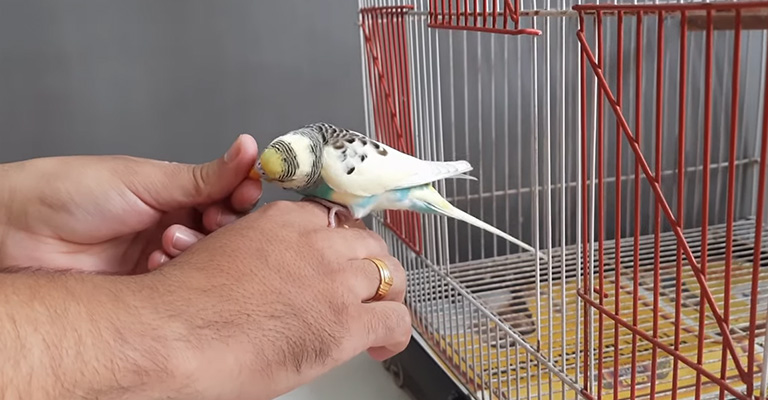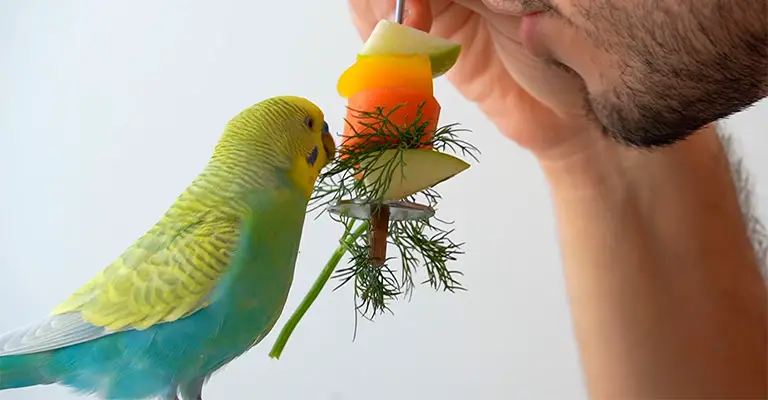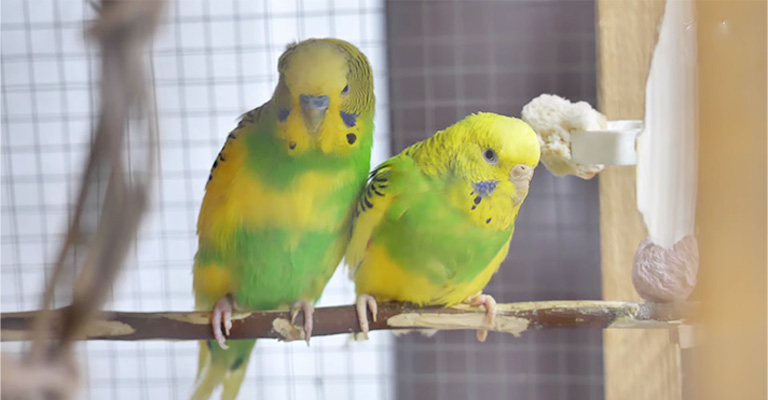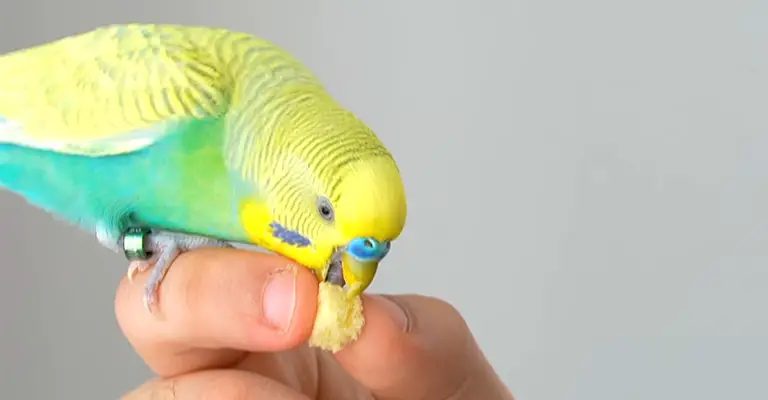Budgies, those charming and lively parakeets, have the remarkable ability to form strong bonds with their human companions. Beyond their vibrant plumage and playful antics, these small birds exhibit affectionate behaviors that are heartwarming to witness.
While their gestures may be subtle, understanding how budgies show affection to humans can deepen the bond between pet and owner. From gentle vocalizations to endearing physical interactions, budgies have unique ways of expressing their fondness.
This article explores the delightful world of budgie-human connections, shedding light on the various ways these feathered friends communicate their affection and loyalty.
As you embark on this journey of companionship with your budgie, take the time to observe and reciprocate their affectionate behaviors.
Whether you’re a seasoned budgie owner or contemplating adopting one, uncovering the signs of budgie affection will undoubtedly enhance your appreciation for these charming avian companions.

How Do Budgies Show Affection to Humans?
Budgies exhibit affection towards humans through a variety of behaviors that reflect their fondness and trust. Here’s how budgies show affection:
Vocal Expressions
Budgies communicate their affection through various vocalizations. Soft chirps, melodious tunes, and even mimicry of human sounds indicate their contentment and happiness in your presence.
Head Bobbing and Nuzzling
A budgie that engages in gentle head bobbing while interacting with you is displaying a sign of affection. They might also nuzzle against your hand or face as an intimate gesture.
Preening Behavior
Budgies often show their affection by preening their human companions. When they gently nibble at your hair, eyelashes, or clothing, it’s a way of caring for you just as they would for a fellow budgie.
Perching on You
Trust is a cornerstone of budgie-human relationships. When your budgie perches on your finger, shoulder, or head, it signifies their comfort and willingness to be close to you.
Wing Spreading and Tail Wiggling
The sight of a budgie spreading its wings and wiggling its tail in your presence is a display of excitement and affection. They are showing off their vibrant feathers to impress and connect with you.
Playing and Sharing Activities
Engaging in interactive activities with your budgie, such as playing games or sharing a meal, enhances your bond. Budgies that eagerly participate show their enthusiasm for spending time with you.
Following and Imitating
Budgies may follow your movements around the room or imitate your actions as a way to be involved in your world. This mimicry showcases their desire to connect and be part of your daily life.
Regurgitation Behavior
While this behavior might seem odd, budgies may regurgitate food to show affection. It’s a maternal gesture, as they might do this for a mate or even a beloved human.
Allopreening
Allopreening refers to budgies gently grooming you with their beaks. This behavior is a sign of trust and deep emotional connection.
Understanding these affectionate behaviors of budgies allows you to reciprocate their feelings in ways they understand. Remember that each budgie has its unique personality, so the way they express affection might vary.
Building a strong bond with your budgie takes time, patience, and genuine care, but the reward is a friendship that enriches both of your lives.
How To Bond With Your Budgie?

Bonding with your budgie requires time, patience, and understanding. Here are some steps to help you create a strong and affectionate bond with your feathered friend:
Create a Calm Environment
Start by placing your budgie’s cage in a quiet, low-traffic area of your home. This helps them feel secure and minimizes stress.
Speak Gently
Talk to your budgie in a soft, calm voice. This helps them get used to your presence and associate your voice with positive interactions.
Offer Treats
Use treats like millet spray or small pieces of fruit as positive reinforcement. Hand-feed treats to create a positive association between you and good experiences.
Slow Approach
Allow your budgie to get used to your presence. Sit near their cage without making sudden movements to avoid startling them.
Open Cage Time
Let your budgie explore outside the cage in a safe, enclosed area. Sit nearby and let them approach you at their own pace.
Respect Their Space
Initially, your budgie might be hesitant to come close. Respect their boundaries and avoid forcing interaction.
Perching on Your Finger
Once your budgie is comfortable with your presence, offer your finger as a perch. Use a gentle approach, and let them step onto your finger voluntarily.
Engage in interactive play sessions with toys. This helps build a positive association with spending time together.
Whistle and Sing
Budgies are drawn to sound. Whistling or singing softly can capture their attention and make them curious about you.
Mirror Play
Budgies often enjoy looking at themselves in mirrors. Placing a small, safe mirror near their cage can be entertaining for them and help them get used to their reflection.
Establish a consistent routine for feeding, cleaning, and spending time with your budgie. This predictability helps build trust.
Observe Body Language
Pay attention to your budgie’s body language. Learn to recognize signs of comfort and discomfort, and adjust your interactions accordingly.
Patience is Key
Building a strong bond takes time. Be patient and allow your budgie to set the pace of the relationship. However, every budgie has its unique personality.
Some might become affectionate quickly, while others might take longer to warm up. The key is to create a positive and nurturing environment where your budgie feels safe and valued.
How Do Budgies Show Affection to Each Other?

Budgies, being social creatures, display affection for each other through a range of behaviors that strengthen their bonds within their flock. Here’s how budgies show affection to one another:
Allopreening
Budgies engage in allopreening, which is mutual grooming. They use their beaks to gently clean and preen each other’s feathers, fostering a sense of closeness and trust.
Cuddling
Budgies often snuggle up to one another, especially during sleep or rest. This physical contact helps them maintain warmth and comfort.
Feeding Each Other
Regurgitating food and feeding it to another budgie is a sign of affection and care. This behavior is commonly observed among bonded pairs and close friends.
Sharing Perches
Budgies that are fond of each other often share perches. Sitting side by side signifies their companionship and the strong social bonds within the flock.
Wing and Tail Touching
Touching wings or tails is a form of physical contact that reinforces their connection. It’s a subtle yet meaningful gesture of affection.
Vocalizations
Budgies communicate through a variety of sounds. Soft chirping and cooing when near each other indicate their comfort and attachment.
Playing Together
Engaging in playful activities like chasing each other, hopping around, and flying together promotes camaraderie and shared enjoyment.
Mutual Exploration
Budgies explore their environment together, showing that they feel secure and comfortable in each other’s company.
Mating and Nesting Behaviors
Breeding pairs of budgies engage in courtship behaviors such as bowing, regurgitating food, and sharing a nesting site. These behaviors solidify their romantic bond.
Defending Each Other
In the wild, budgies protect each other from potential threats. When one budgie warns others of danger with alarm calls, it demonstrates their collective concern.
Mirror Interaction
Budgies may interact with mirrors as if they were interacting with another budgie. This indicates a desire for companionship and social interaction.
Understanding how budgies express affection to each other provides insight into their natural behaviors and social dynamics. Creating a nurturing and stimulating environment for your pet budgie can help replicate some of these affectionate interactions.
Do Budgies Like Being Held?

Whether or not budgies like being held depends on their individual personalities and past experiences with human interaction.
Some budgies enjoy being held and even seek out human interaction, while others may be more reserved or cautious. Here’s how to approach holding budgies:
Build Trust
Before attempting to hold your budgie, it’s crucial to establish trust. Spend time near the cage, talk to them in a gentle tone, and offer treats from your hand to create a positive association with your presence.
Choose the Right Moment
Choose a time when your budgie is calm and relaxed. Avoid trying to hold them during stressful moments, like when they are eating or during their active times.
Move Slowly
Approach your budgie slowly and avoid sudden movements that might startle them. Extend your hand toward them at a calm and steady pace.
Offer a Perch
To hold a budgie, offer them a finger as a perch. Gently place your finger near their feet and allow them to step onto it voluntarily. Never grab or force them onto your finger.
Support Their Feet
When they step onto your finger, ensure that their feet are comfortable and have a firm grip. Don’t squeeze their feet; they should feel secure.
Once they are on your finger, keep your hand steady and level. Speak softly to reassure them.
Short Intervals
Especially in the beginning, limit the time you hold them to short intervals, gradually extending the time as they become more comfortable.
Watch for Signs
Observe your budgie’s body language. If they appear anxious, try to gently place them back on a perch in their cage.
Be Respectful
If your budgie seems hesitant or resistant, respect their feelings. Not all budgies will enjoy being held, and it’s essential to consider their preferences.
Positive Reinforcement
Reward them with treats and gentle praise after the interaction, regardless of how short it was. This helps them associate positive experiences with being held.
Remember that patience and respect for your budgie’s comfort level are key. Over time, consistent positive interactions can help your budgie become more comfortable with being held.
FAQs
It’s generally not advisable to attempt holding your budgie on the first day. Allow them to acclimate to their new environment and your presence before attempting any physical contact.
If your budgie flies away when you attempt to hold it, don’t force the interaction. Continue building trust through positive experiences, and try again when they are more comfortable.
To help your budgie enjoy being held, use positive reinforcement. Offer treats, speak gently, and be patient. Gradually increase the time you spend holding them as they become more comfortable.
Biting can be a sign of fear or discomfort. If your budgie bites, give them space and work on building trust gradually. Avoid reacting negatively, as this can reinforce the behavior.
Budgies might be more receptive to being held during their calm periods, often in the early morning or evening. Avoid holding them during their active times or when they are eating.
Conclusion
The relationship between budgies and humans is a heartwarming testament to the capacity for affection in the animal kingdom. These small parakeets have a remarkable ability to express their fondness through a variety of endearing gestures.
From soft chirps and melodious tunes to eager head bobs and gentle preening, budgies create a unique language of connection that transcends the barrier between species.
Whether it’s the contented purr of their feathers against your touch or the trust they place in you as they perch on your finger, each interaction strengthens the bond you share.
By providing a nurturing environment, spending quality time together, and respecting their individual personalities, you can foster a relationship that is not only based on care but also genuine affection.
So, relish those moments of shared joy and laughter, for in the flutter of wings and the sparkle in their eyes.
Budgies, those charming and lively parakeets, have the remarkable ability to form strong bonds with their human companions. Beyond their vibrant plumage and playful antics, these small birds exhibit affectionate behaviors that are heartwarming to witness.
While their gestures may be subtle, understanding how do budgies show affection to humans can deepen the bond between pet and owner. From gentle vocalizations to endearing physical interactions, budgies have unique ways of expressing their fondness.
This article explores the delightful world of budgie-human connections, shedding light on the various ways these feathered friends communicate their affection and loyalty.
As you embark on this journey of companionship with your budgie, take the time to observe and reciprocate their affectionate behaviors.
Whether you’re a seasoned budgie owner or contemplating adopting one, uncovering the signs of budgie affection will undoubtedly enhance your appreciation for these charming avian companions.
How Do Budgies Show Affection to Humans?
Budgies exhibit affection towards humans through a variety of behaviors that reflect their fondness and trust. Here’s how budgies show affection:
Vocal Expressions
Budgies communicate their affection through various vocalizations. Soft chirps, melodious tunes, and even mimicry of human sounds indicate their contentment and happiness in your presence.
Head Bobbing and Nuzzling
A budgie that engages in gentle head bobbing while interacting with you is displaying a sign of affection. They might also nuzzle against your hand or face as an intimate gesture.
Preening Behavior
Budgies often show their affection by preening their human companions. When they gently nibble at your hair, eyelashes, or clothing, it’s a way of caring for you just as they would for a fellow budgie.
Perching on You
Trust is a cornerstone of budgie-human relationships. When your budgie perches on your finger, shoulder, or head, it signifies their comfort and willingness to be close to you.
Wing Spreading and Tail Wiggling
The sight of a budgie spreading its wings and wiggling its tail in your presence is a display of excitement and affection. They are showing off their vibrant feathers to impress and connect with you.
Playing and Sharing Activities
Engaging in interactive activities with your budgie, such as playing games or sharing a meal, enhances your bond. Budgies that eagerly participate show their enthusiasm for spending time with you.
Following and Imitating
Budgies may follow your movements around the room or imitate your actions as a way to be involved in your world. This mimicry showcases their desire to connect and be part of your daily life.
Regurgitation Behavior
While this behavior might seem odd, budgies may regurgitate food to show affection. It’s a maternal gesture, as they might do this for a mate or even a beloved human.
Allopreening
Allopreening refers to budgies gently grooming you with their beaks. This behavior is a sign of trust and deep emotional connection.
Understanding these affectionate behaviors of budgies allows you to reciprocate their feelings in ways they understand. Remember that each budgie has its unique personality, so the way they express affection might vary.
Building a strong bond with your budgie takes time, patience, and genuine care, but the rewards are a friendship that enriches both your lives.
How To Bond with Your Budgie?
Bonding with your budgie requires time, patience, and understanding. Here are some steps to help you create a strong and affectionate bond with your feathered friend:
Create a Calm Environment
Start by placing your budgie’s cage in a quiet, low-traffic area of your home. This helps them feel secure and minimizes stress.
Speak Gently
Talk to your budgie in a soft, calm voice. This helps them get used to your presence and associate your voice with positive interactions.
Offer Treats
Use treats like millet spray or small pieces of fruits as positive reinforcement. Hand-feed treats to create a positive association between you and good experiences.
Slow Approach
Allow your budgie to get used to your presence. Sit near their cage without making sudden movements to avoid startling them.
Open Cage Time
Let your budgie explore outside the cage in a safe, enclosed area. Sit nearby and let them approach you at their own pace.
Respect Their Space
Initially, your budgie might be hesitant to come close. Respect their boundaries and avoid forcing interaction.
Perching on Your Finger
Once your budgie is comfortable with your presence, offer your finger as a perch. Use a gentle approach, and let them step onto your finger voluntarily.
Engage in interactive play sessions with toys. This helps build a positive association with spending time together.
Whistle and Sing
Budgies are drawn to sound. Whistling or singing softly can capture their attention and make them curious about you.
Mirror Play
Budgies often enjoy looking at themselves in mirrors. Placing a small, safe mirror near their cage can be entertaining for them and help them get used to their reflection.
Establish a consistent routine for feeding, cleaning, and spending time with your budgie. This predictability helps build trust.
Observe Body Language
Pay attention to your budgie’s body language. Learn to recognize signs of comfort and discomfort, and adjust your interactions accordingly.
Patience is Key
Building a strong bond takes time. Be patient and allow your budgie to set the pace of the relationship. However, every budgie has its unique personality.
Some might become affectionate quickly, while others might take longer to warm up. The key is to create a positive and nurturing environment where your budgie feels safe and valued.
How Do Budgies Show Affection to Each Other?
Budgies, being social creatures, display affection to each other through a range of behaviors that strengthen their bonds within their flock. Here’s how budgies show affection to one another:
Allopreening
Budgies engage in allopreening, which is mutual grooming. They use their beaks to gently clean and preen each other’s feathers, fostering a sense of closeness and trust.
Cuddling
Budgies often snuggle up to one another, especially during sleep or rest. This physical contact helps them maintain warmth and comfort.
Feeding Each Other
Regurgitating food and feeding it to another budgie is a sign of affection and care. This behavior is commonly observed among bonded pairs and close friends.
Sharing Perches
Budgies that are fond of each other often share perches. Sitting side by side signifies their companionship and the strong social bonds within the flock.
Wing and Tail Touching
Touching wings or tails is a form of physical contact that reinforces their connection. It’s a subtle yet meaningful gesture of affection.
Vocalizations
Budgies communicate through a variety of sounds. Soft chirping and cooing when near each other indicate their comfort and attachment.
Playing Together
Engaging in playful activities like chasing each other, hopping around, and flying together promotes camaraderie and shared enjoyment.
Mutual Exploration
Budgies explore their environment together, showing that they feel secure and comfortable in each other’s company.
Mating and Nesting Behaviors
Breeding pairs of budgies engage in courtship behaviors such as bowing, regurgitating food, and sharing a nesting site. These behaviors solidify their romantic bond.
Defending Each Other
In the wild, budgies protect each other from potential threats. When one budgie warns others of danger with alarm calls, it demonstrates their collective concern.
Mirror Interaction
Budgies may interact with mirrors as if they were interacting with another budgie. This indicates a desire for companionship and social interaction.
Understanding how budgies express affection to each other provides insight into their natural behaviors and social dynamics. Creating a nurturing and stimulating environment for your pet budgie can help replicate some of these affectionate interactions.
Do Budgies Like Being Held?
Whether or not budgies like being held depends on their individual personalities and past experiences with human interaction.
Some budgies enjoy being held and even seek out human interaction, while others may be more reserved or cautious. Here’s how to approach holding budgies:
Build Trust
Before attempting to hold your budgie, it’s crucial to establish trust. Spend time near the cage, talk to them in a gentle tone, and offer treats from your hand to create a positive association with your presence.
Choose the Right Moment
Choose a time when your budgie is calm and relaxed. Avoid trying to hold them during stressful moments, like when they are eating or during their active times.
Move Slowly
Approach your budgie slowly and avoid sudden movements that might startle them. Extend your hand toward them at a calm and steady pace.
Offer a Perch
To hold a budgie, offer them a finger as a perch. Gently place your finger near their feet and allow them to step onto it voluntarily. Never grab or force them onto your finger.
Support Their Feet
When they step onto your finger, ensure that their feet are comfortable and have a firm grip. Don’t squeeze their feet; they should feel secure.
Once they are on your finger, keep your hand steady and level. Speak softly to reassure them.
Short Intervals
Especially in the beginning, limit the time you hold them to short intervals, gradually extending the time as they become more comfortable.
Watch for Signs
Observe your budgie’s body language. If they appear anxious, try to gently place them back on a perch in their cage.
Be Respectful
If your budgie seems hesitant or resistant, respect their feelings. Not all budgies will enjoy being held, and it’s essential to consider their preferences.
Positive Reinforcement
Reward them with treats and gentle praise after the interaction, regardless of how short it was. This helps them associate positive experiences with being held.
Remember that patience and respect for your budgie’s comfort level are key. Over time, consistent positive interactions can help your budgie become more comfortable with being held.
FAQs
Can I Hold My Budgie on the First Day?
It’s generally not advisable to attempt holding your budgie on the first day. Allow them to acclimate to their new environment and your presence before attempting any physical contact.
What if My Budgie Flies Away When I Try to Hold It?
If your budgie flies away when you attempt to hold it, don’t force the interaction. Continue building trust through positive experiences, and try again when they are more comfortable.
How Can I Teach My Budgie to Enjoy Being Held?
To help your budgie enjoy being held, use positive reinforcement. Offer treats, speak gently, and be patient. Gradually increase the time you spend holding them as they become more comfortable.
My Budgie Bites When I Try to Hold It. What Should I Do?
Biting can be a sign of fear or discomfort. If your budgie bites, give them space and work on building trust gradually. Avoid reacting negatively, as this can reinforce the behavior.
Are There Certain Times When Budgies Prefer Being Held?
Budgies might be more receptive to being held during their calm periods, often in the early morning or evening. Avoid holding them during their active times or when they are eating.
Conclusion
The relationship between budgies and humans is a heartwarming testament to the capacity for affection in the animal kingdom. These small parakeets have a remarkable ability to express their fondness through a variety of endearing gestures.
From soft chirps and melodious tunes to eager head bobs and gentle preening, budgies create a unique language of connection that transcends the barrier between species.
Whether it’s the contented purr of their feathers against your touch or the trust they place in you as they perch on your finger, each interaction strengthens the bond you share.
By providing a nurturing environment, spending quality time together, and respecting their individual personalities, you can foster a relationship that is not only based on care but also genuine affection.
So, relish those moments of shared joy and laughter, for in the flutter of wings and the sparkle in their eyes.